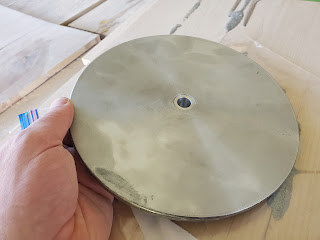I bought a hand plane back on the ol' table project from Harbor Freight. While I could "manage", there are some issues with it. The one that made it nearly impossible to use was one of the knurled nuts that adjusted the depth of cut on the blade. I expect that someone made an adjustment on the parts for the threaded shafts from a 6x1.0mm thread to a 8x1.0mm thread (or the other direction - I can't be sure).
The one I bought had two 6x1.0mm threaded shafts, one 6x1.0mm knurled nut, and one 8x1.0mm knurled nut.
When I contacted Harbor Freight, they just said I'd have to buy a new one. Bad customer service there (but that was an anomaly, possibly). I set the tightness on the blade and muddled through the table project. Not the greatest experience, but I coped.
Well, I got tired of having that thing sitting around, so I took a few measurements, and made sure I had the 6x1.0mm tap on hand. I rummaged through my collection of drops, and found a 5/8" stainless steel bar that I could use. Should be fairly easy to whip through it (ominous foreboding), right?
The bar was chucked into a 5C collet, and faced off. Then, I drilled it with a #6 drill bit, which is 0.204" or (5.18mm, since this is a metric part). As an FYI, a 5.2mm drill bit is the right size to tap aluminum. I was even smaller, so I purely thought I could get perfect threads out of this. I commenced tapping.
At some point, you cut your losses and give up on tapping this stupid part all the way through. That's when I found the pre-existing part was NOT tapped all the way through, either. When I measured to the threads, I found it was about a half inch or 12mm of thread. I made the decision that I would stop trying to run threads at this stage, and drill for clearance later (after it was removed from the lathe so I could actually get to the back side of the hole), and then I'd hand-tap the rest of the way.
I moved on to the next step - knurling. I also took the time to do some knurling. This was my first chance at using the scissor knurling tools, instead of the pressure knurling tools. If you think your knurling is impossible, and you use the pressure knurling tools, just stop what you are doing and buy a scissor knurling tool. Just do it. You can thank me later. Anyway, the knurl came out way better than any knurling I've ever done.
So, I finished the bosses and other dimensions. The stainless sure is going to look good.
I parted it off.
I drilled out the back side until I had about 3/8" of thread meat left (that's 8mm, this is a metric part). I then went outside and manually tapped this thing for another hour and a half. This stainless is brutal! But, I got it done.
I had to give it a fitness test, and yes, this is going to work. I might need to do some more filing to get a perfect fit, but the reality is that this will suffice better than the original 8x1.0mm part.
You can tell which one is mine - it has the machined bevel on it (the one on the right side), so it's not a lazy casting of unidentified-origin metal.
This hand plane is now fully functional. I might need to make a spacer for the wood handle so that it can be anchored, but at least it's usable now.























































